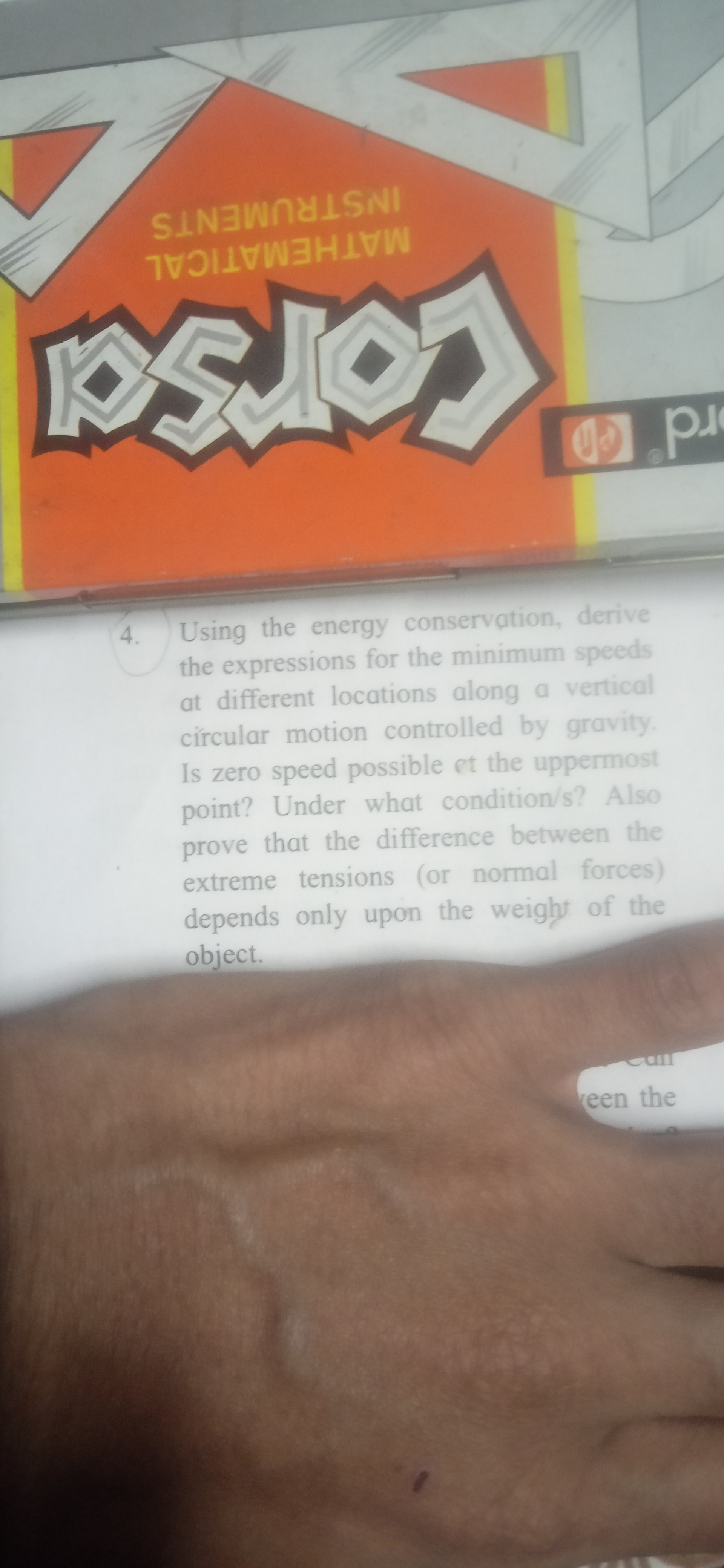Using the energy conservation, derive the expressions for the minimum speeds at different locations along a vertical circular motion controlled by gravity. Is zero speed possible a... Using the energy conservation, derive the expressions for the minimum speeds at different locations along a vertical circular motion controlled by gravity. Is zero speed possible at the uppermost point? Under what condition/s? Also prove that the difference between the extreme tensions (or normal forces) depends only upon the weight of the object.

Understand the Problem
The question asks to derive expressions for the minimum speeds needed for an object to execute vertical circular motion, controlled by gravity. It also inquires about the feasibility of the object having zero speed at the highest point of the motion and under what conditions this could occur. Additionally, it asks to demonstrate that the difference in extreme tensions (or normal forces) depends solely on the weight of the object.
Answer
Minimum speeds are \( v_{top} = \sqrt{gR} \) and \( v_{bottom} = \sqrt{5gR} \). Zero speed at the top is possible at the minimum speed condition, and tension difference depends solely on weight.
Answer for screen readers
The minimum speeds needed for vertical circular motion are:
- At the top: ( v_{top} = \sqrt{gR} )
- At the bottom: ( v_{bottom} = \sqrt{5gR} )
Zero speed at the top is possible at the exact minimum speed condition. The difference in tension solely depends on the weight of the object.
Steps to Solve
- Understand Energy Conservation in Circular Motion
The total mechanical energy in vertical circular motion is conserved. The total energy at the highest point is given by the gravitational potential energy and the kinetic energy at that point.
- Write Equations for Different Points
At the highest point of the circular path, where the speed is ( v_{top} ), the potential energy is maximum. Thus:
- At the top: $$ E_{top} = mgh + \frac{1}{2}mv_{top}^2 $$
At the bottom, where the speed is ( v_{bottom} ):
- At the bottom: $$ E_{bottom} = mg(0) + \frac{1}{2}mv_{bottom}^2 $$
- Set Total Energies Equal
Since energy is conserved: $$ mgh + \frac{1}{2}mv_{top}^2 = mg(0) + \frac{1}{2}mv_{bottom}^2 $$
- Derive Expressions for Minimum Speeds
Now isolate ( v_{top} ) and ( v_{bottom} ):
- ( v_{top} = \sqrt{gR} ) (minimum speed at the top)
- ( v_{bottom} = \sqrt{5gR} ) (minimum speed at the bottom)
- Consider Zero Speed at the Top
For zero speed at the top, ( v_{top} = 0 ):
- To maintain circular motion, the centripetal force must equal gravitational force: $$ \frac{mv_{top}^2}{R} = mg $$ This gives ( v_{top}^2 = gR ), so ( v_{top} = 0 ) is possible only if the object is at the exact minimum speed condition.
- Analyze Difference in Tensions
The tensions (or normal forces) can be analyzed:
- At the top, the centripetal force is given by: $$ T_{top} + mg = \frac{mv_{top}^2}{R} $$
- At the bottom: $$ T_{bottom} - mg = \frac{mv_{bottom}^2}{R} $$
- Prove Dependence on Weight
Substitute the expressions for ( T_{top} ) and ( T_{bottom} ):
- The difference in tensions is: $$ T_{bottom} - T_{top} = mg + \left( \frac{mv_{bottom}^2}{R} \right) - \left( mg - \frac{mv_{top}^2}{R} \right) = \frac{mv_{bottom}^2 - mv_{top}^2}{R} $$
This shows that the difference relies solely on ( mg ), the weight of the object.
The minimum speeds needed for vertical circular motion are:
- At the top: ( v_{top} = \sqrt{gR} )
- At the bottom: ( v_{bottom} = \sqrt{5gR} )
Zero speed at the top is possible at the exact minimum speed condition. The difference in tension solely depends on the weight of the object.
More Information
In vertical circular motion, the gravitational effect is strong enough to influence the needed speeds at various points. The centripetal force requirements lead to the conditions established for maintaining the circular path.
Tips
- Ignoring the role of gravitational potential energy when deriving speeds.
- Miscalculating the results for forces leading to physics inconsistencies.
- Assuming zero speed at the top without considering the dynamics of tension and weight.
AI-generated content may contain errors. Please verify critical information